
Home - Search - Browse - Alphabetic Index: 0- 1- 2- 3- 4- 5- 6- 7- 8- 9
A- B- C- D- E- F- G- H- I- J- K- L- M- N- O- P- Q- R- S- T- U- V- W- X- Y- Z
Chang Zheng 1
 CZ-1 Impact |
AKA: Chang Zheng-1;CSL-1;CZ-1;Long March 1. Status: Retired 2002. First Launch: 1969-11-16. Last Launch: 1971-03-03. Number: 3 . Payload: 300 kg (660 lb). Thrust: 1,020.00 kN (229,300 lbf). Gross mass: 81,310 kg (179,250 lb). Height: 29.40 m (96.40 ft). Diameter: 2.25 m (7.38 ft). Apogee: 440 km (270 mi).
After shutdown of the second stage, the vehicle flew in a powerless glide for over 200 seconds before the third stage separated and ignited. An attitude control system using residual liquid propellant was added to the second stage to control the vehicle in zero-G during the coast. After separation of the second stage, the third stage was spun up to 180 revolutions/minute using a small spin rocket to keep it in stable flight during the solid motor burn.
The development of the solid rocket upper stage was a significant new technology for China in the late 1960's. The third stage motor for the CZ-1 had a diameter of 770 mm, a length of 4 m, and 1.8 metric tons of propellant – far beyond any previous solid motor in China. There was additionally the requirement for reliable high-altitude ignition while spinning at high speed. From May 1969 to January 1970, four full thrust tests of the solid engine under different conditions and one flight test of the two-stage modification of the DF-3 were carried out successfully. On 24 April, 1970, the CZ-1 placed the DFH-1 satellite into orbit on the first attempt. Less than a year later, the back-up vehicle was used to launch the SJ-1 scientific satellite.
LEO Payload: 300 kg (660 lb) to a 440 km orbit. Payload: 250 kg (550 lb) to a GTO.
Stage Data - CZ-1
- Stage 1. 1 x CZ-1-1. Gross Mass: 64,100 kg (141,300 lb). Empty Mass: 4,100 kg (9,000 lb). Thrust (vac): 1,224.575 kN (275,295 lbf). Isp: 268 sec. Burn time: 130 sec. Isp(sl): 241 sec. Diameter: 2.25 m (7.38 ft). Span: 4.00 m (13.10 ft). Length: 17.84 m (58.53 ft). Propellants: Nitric acid/UDMH. No Engines: 4. Engine: YF-2A. Status: In Production.
- Stage 2. 1 x CZ-1-2. Gross Mass: 15,000 kg (33,000 lb). Empty Mass: 2,700 kg (5,900 lb). Thrust (vac): 306.143 kN (68,824 lbf). Isp: 275 sec. Burn time: 110 sec. Isp(sl): 200 sec. Diameter: 2.25 m (7.38 ft). Span: 2.25 m (7.38 ft). Length: 5.35 m (17.55 ft). Propellants: Nitric acid/UDMH. No Engines: 1. Engine: YF-2A. Status: In Production. Comments: Masses, engine performance estimated based on successor improved stage and YF-2 engines in first stage.
- Stage 3. 1 x CZ-1-3. Gross Mass: 2,050 kg (4,510 lb). Empty Mass: 250 kg (550 lb). Thrust (vac): 180.991 kN (40,688 lbf). Isp: 254 sec. Burn time: 38 sec. Diameter: 0.77 m (2.52 ft). Span: 0.77 m (2.52 ft). Length: 3.95 m (12.95 ft). Propellants: Solid. No Engines: 1. Engine: GF-02. Status: Out of Production.
More at: Chang Zheng 1.
Family: orbital launch vehicle. Country: China. Engines: YF-2A. Spacecraft: DFH-1. Launch Sites: Jiuquan, Jiuquan LA2A. Stages: CZ-1-2, CZ-YF-2, GF-02. Agency: CALT. Bibliography: 2, 42, 5, 532, 534, 6, 61.
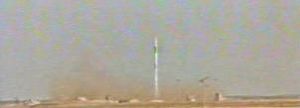 | CZ-1 Launch |
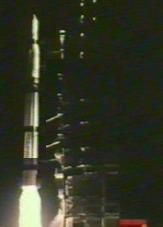 | CZ-1 |
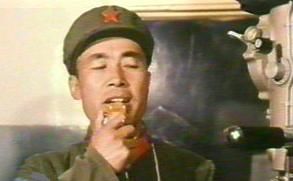 | CZ-1 launch order |
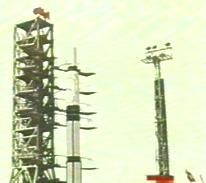 | CZ-1 on pad |
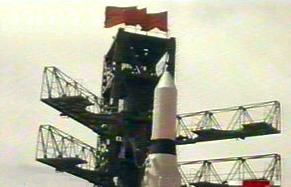 | CZ-1 on pad |
 | CZ-1 Impact |
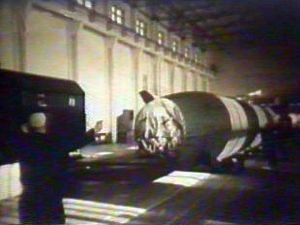 | CZ-1 Assembly |
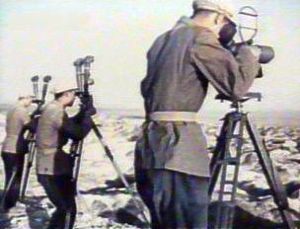 | CZ-1 Launch |
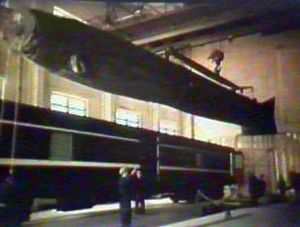 | CZ-1 Assembly |
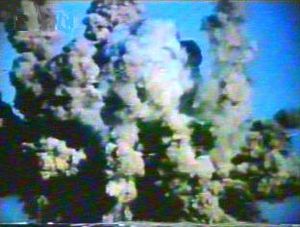 | CZ-1 Impact |
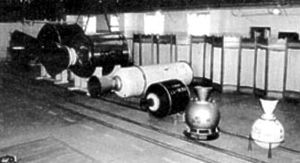 | Chinese solids |
January 1965 - . LV Family: DF-3. Launch Vehicle: Chang Zheng 1.
- Project 651 - . Nation: China. Related Persons: Tsien. Spacecraft: DFH-1. Tsien presents his plan for a Chinese satellite to the Central Committee..
1965 April 29 - . LV Family: DF-3. Launch Vehicle: Chang Zheng 1.
- Chinese satellite plans. - . Nation: China. Related Persons: Tsien. Spacecraft: DFH-1. Tsien says he can orbit a Chiense satellite in 1970 or 1971..
1965 August 10 - . LV Family: DF-3. Launch Vehicle: Chang Zheng 1.
- Project 651 - . Nation: China. Related Persons: Tsien. Spacecraft: DFH-1. Zhou En Lai approves the plan for the construction and launch of China's first satellite..
May 1966 - . LV Family: DF-3. Launch Vehicle: Chang Zheng 1.
- DFH-1 satellite defined. - . Nation: China. Related Persons: Tsien. Spacecraft: DFH-1. The satellite will be launched by the CZ-1 launch vehicle, a DFH-2 IRBM with a new upper stage..
1966 June 6 - . LV Family: DF-3. Launch Vehicle: Chang Zheng 1.
- Cultural Revolution - . Nation: China. Related Persons: Tsien. Tsien is now head of the Seventh Ministry of Machine Building (the former Fifth Academy). Cadres accuse Tsien of spreading Nazi propaganda in China after his visit to Germany in 1946..
1967 January 23 - . LV Family: DF-3. Launch Vehicle: Chang Zheng 1.
- Tsien removed - .
Nation: China.
Related Persons: Tsien.
Spacecraft: DFH-1.
Tsien was overthrown by the 916 (Mao) Clique. Ye Zhengguang, a missile engineer, with the approval off Zhou En Lai and Marshall Nie, confronts Tsien and removes him from his post as head of the Seventh Ministry. Minister of Machine Building Wang Bingzhang was also deposed. However Tsien was protected by the leadership, made a 'Vice Minister', and claimed he supports the coup. Wang refused to cooperate and would not hand over the chops of his office to the 916 Clique.
1968 June 8 - . LV Family: DF-3. Launch Vehicle: Chang Zheng 1.
- Height of Cultural Revolution - . Nation: China. Related Persons: Tsien. Spacecraft: DFH-1. Yao Tongbin, a metallurgist at he Seventh Ministry, is beaten to death by Red Guards. Zhou En Lai intervenes, putting the top fifty missile scientists under this protection..
1969 November 16 - . Launch Site: Jiuquan. Launch Complex: Jiuquan LA2A. LV Family: DF-3. Launch Vehicle: Chang Zheng 1. FAILURE: The program distributor in the second stage broke down. The rocket crashed into the earth within view of the launch site after 69 seconds of flight.. Failed Stage: 2.
- First Chinese satellite launch attempt ends in failure. - .
Payload: DFH 1. Mass: 170 kg (370 lb). Nation: China.
Class: Technology.
Type: Navigation technology satellite. Spacecraft: DFH-1.
COSPAR: F691116Z.
The launch vehicle arrived at the site on 18 March 1969. The objective was to launch China's first satellite before Japan lofted its counterpart. Ren Xinmin had obtained this specific order from Deng Hsiao Peng. Great difficulties were encountered in the middle of the Cultural Revolution, including the sending of most of the satellite engineers to work on irrigation ditch construction in the provinces. The skirt for the satellite, designed to make it easily visible to ground observors, had to be made from a special silk produced in a factory without the knowledge of the Red Guards. The engineers went by bus to a department store in Beijing to study an imported folding umbrella as a model for the deployment mechanism -- they could not afford to buy it. The entire launch was kept secret until a documentary was released in 2001.
1970 April 24 - . LV Family: DF-3. Launch Vehicle: Chang Zheng 1.
- DFH-1 satellite launch authorised. - . Nation: China. Related Persons: Tsien. Spacecraft: DFH-1. Mao personally authorises the launch..
1970 April 24 - . 13:35 GMT - . Launch Site: Jiuquan. Launch Complex: Jiuquan LA2A. LV Family: DF-3. Launch Vehicle: Chang Zheng 1.
- DFH Mao 1 - .
Payload: DFH 1. Mass: 173 kg (381 lb). Nation: China.
Agency: MAI.
Class: Technology.
Type: Navigation technology satellite. Spacecraft: DFH-1.
USAF Sat Cat: 4382 . COSPAR: 1970-034A. Apogee: 2,162 km (1,343 mi). Perigee: 434 km (269 mi). Inclination: 68.40 deg. Period: 111.60 min.
The final campaign to launch China's first satellite began on April 1, 1970, when two DFH-1 satellites and the CZ-1 rocket arrived by train at the Jiuquan Satellite Launch Centre. This was over a year after the first attempt in 1969. Ren Xinmin was project leader and Qi Faren was leader of the DFH-1 experiment team. On April 2 Premier Zhou Enlai called a special meeting in the Great Hall of the People in Beijing for a final readiness review of the satellite and the launch vehicle. Zhou wanted special guarantees that the satellite would transmit the march 'The East is Red' from orbit.
On the morning of April 24, 1970, the first and second stages of CZ-1 were loaded with propellant and stacked. The satellite was mated to the spin-stabilized solid-propellant third stage, and the launcher entered the final eight hours of launch preparation. Weather forecast for the launch at 9:30 p.m. called for clouds at above 7,000 meters and a wind speed of less than 4 to 5 meters per second.
The historic launch came at 9:35 p.m. local time (13:35 UTC). Upon hearing the command "ignition", a launch controller pressed the button to start the rocket engines. The three-stage CZ-1, which was 29.46 meters tall and had a maximum diameter of 2.25 meters, lifted off the launch pad with a thrust of 104 tonnes. Liftoff weight of the CZ-1 was 81.5 tonnes. Rocket expert Shen Jianan recounted that "..as soon as I saw the liftoff on the TV screen inside the bunker, I ran outside. I could only see the beautiful rocket lighting up the night sky and streaking towards the southeast. I ran back inside to listen to the transmissions. Broadcasting on the speaker were status reports like 'capturing target', 'nominal tracking', 'nominal flight', 'nominal second and third stage separation'..." Thirteen minutes after launch, at 9:48 p.m., mission control announced "...satellite and rocket stage separation, satellite enters orbit...the bunker was filled with cheers".
China became the fifth nation after the former Soviet Union, the United States, France and Japan to achieve an indigenous space launch capability. At 9:50 p.m., the National Broadcasting Bureau announced the acquisition of the tune 'East is Red' from the satellite loud and clear. In the following days, the People's Central Broadcasting radio and newspapers in Beijing announced and printed worldwide times of DFH-1 and CZ-1 third stage passages, and directions of travel in the sky. Senior officials in Beijing dispatched a chartered plane to JSLC to bring back Qi and other scientists. In the International Labour Day celebration on May 1, Chairman Mao and Premier Zhou warmly welcomed them at the Tiananmen Square.
1971 March 3 - . 12:15 GMT - . Launch Site: Jiuquan. Launch Complex: Jiuquan LA2A. LV Family: DF-3. Launch Vehicle: Chang Zheng 1.
- SJ-1 - . Payload: Shi Jian 1. Mass: 221 kg (487 lb). Nation: China. Agency: MAI. Class: Technology. Type: Communications technology satellite. Spacecraft: DFH-1. Decay Date: 1979-06-17 . USAF Sat Cat: 5007 . COSPAR: 1971-018A. Apogee: 1,833 km (1,138 mi). Perigee: 265 km (164 mi). Inclination: 69.80 deg. Period: 106.10 min. Similar in appearance to the American Telstar and conducted communications technology tests..
Back to top of page
Home - Search - Browse - Alphabetic Index: 0- 1- 2- 3- 4- 5- 6- 7- 8- 9
A- B- C- D- E- F- G- H- I- J- K- L- M- N- O- P- Q- R- S- T- U- V- W- X- Y- Z
© 1997-2019 Mark Wade - Contact
© / Conditions for Use